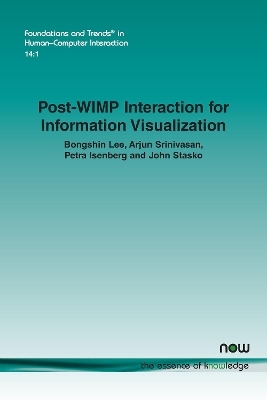
Post-WIMP Interaction for Information Visualization
Seiten
2021
now publishers Inc (Verlag)
978-1-68083-826-8 (ISBN)
now publishers Inc (Verlag)
978-1-68083-826-8 (ISBN)
Presents a condensed summary of research efforts investigating post-WIMP interaction techniques in visualization systems. The authors discuss the main challenges faced, lessons learned, and reflect on how their perspectives and viewpoints on post-WIMP for InfoVis have evolved.
Interaction, a means for people to express their goals and intentions to systems, plays a critical role in information visualization (InfoVis). The importance of interaction grows as the size and complexity of data increases. Well-designed interactions empower people to effectively complete tasks with visualized data and can provide a more fluid and engaging experience. Both industry and the broad human-computer interaction (HCI) research community have made significant advancements in hardware and software technologies that can be leveraged to support novel interaction techniques. Well-designed interactions for visualization systems hold great promise both for empowering people to effectively complete their tasks and for providing more natural and engaging user experiences. With the advancements in hardware and software technology, the visualization research community has made considerable progress on providing novel input and interaction experiences and continues to advance at a fast pace. Thus, it seems timely to look back at what has been achieved so far and contemplate what might be possible in the future. In this monograph, the authors first present a condensed summary of research efforts investigating post-WIMP interaction techniques in visualization systems. They include research from the broader HCI community and several product releases from industry that have influenced visualization interfaces. Furthermore, they reflect on their own projects that investigated post-WIMP InfoVis interaction and systems. The authors discuss the main challenges faced, lessons learned, and reflect on how their perspectives and viewpoints on post-WIMP for InfoVis have evolved over the course of these projects. Finally, they identify several open research directions that will help realize the full potential of post-WIMP interaction for and with InfoVis; expanding the boundaries of InfoVis and reaching a broader audience.
Interaction, a means for people to express their goals and intentions to systems, plays a critical role in information visualization (InfoVis). The importance of interaction grows as the size and complexity of data increases. Well-designed interactions empower people to effectively complete tasks with visualized data and can provide a more fluid and engaging experience. Both industry and the broad human-computer interaction (HCI) research community have made significant advancements in hardware and software technologies that can be leveraged to support novel interaction techniques. Well-designed interactions for visualization systems hold great promise both for empowering people to effectively complete their tasks and for providing more natural and engaging user experiences. With the advancements in hardware and software technology, the visualization research community has made considerable progress on providing novel input and interaction experiences and continues to advance at a fast pace. Thus, it seems timely to look back at what has been achieved so far and contemplate what might be possible in the future. In this monograph, the authors first present a condensed summary of research efforts investigating post-WIMP interaction techniques in visualization systems. They include research from the broader HCI community and several product releases from industry that have influenced visualization interfaces. Furthermore, they reflect on their own projects that investigated post-WIMP InfoVis interaction and systems. The authors discuss the main challenges faced, lessons learned, and reflect on how their perspectives and viewpoints on post-WIMP for InfoVis have evolved over the course of these projects. Finally, they identify several open research directions that will help realize the full potential of post-WIMP interaction for and with InfoVis; expanding the boundaries of InfoVis and reaching a broader audience.
1. Introduction
2. History
3. Reflections and Viewpoints
4. Looking Ahead
5. Conclusions
Acknowledgements
References
| Erscheinungsdatum | 21.06.2021 |
|---|---|
| Reihe/Serie | Foundations and Trends® in Human-Computer Interaction |
| Verlagsort | Hanover |
| Sprache | englisch |
| Maße | 156 x 234 mm |
| Gewicht | 165 g |
| Themenwelt | Informatik ► Software Entwicklung ► User Interfaces (HCI) |
| ISBN-10 | 1-68083-826-1 / 1680838261 |
| ISBN-13 | 978-1-68083-826-8 / 9781680838268 |
| Zustand | Neuware |
| Haben Sie eine Frage zum Produkt? |
Mehr entdecken
aus dem Bereich
aus dem Bereich
Aus- und Weiterbildung nach iSAQB-Standard zum Certified Professional …
Buch | Hardcover (2023)
dpunkt Verlag
CHF 48,85
Lean UX und Design Thinking: Teambasierte Entwicklung …
Buch | Hardcover (2022)
dpunkt (Verlag)
CHF 48,85
Wissensverarbeitung - Neuronale Netze
Buch | Hardcover (2023)
Carl Hanser (Verlag)
CHF 48,95


